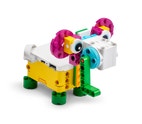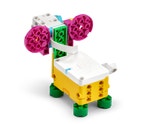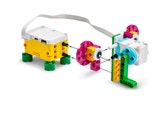Animal Structures
Maria sees an elephant eating. She wonders about ways elephants can use their trunks. Help her learn.

Prepare
(NOTE: This lesson contains a Part A and a Part B. Both are important to access the full learning of the curriculum. If time is limited, review both parts to choose elements that meet your students’ needs.)
In this lesson, students will build an elephant with a movable trunk, using the example image(s) for inspiration. Encourage them to design and build their own idea for this elephant and its trunk.
- Build Prior Knowledge - Living Things: Using your core science materials, share information, images and definitions to build prior knowledge.
- Animals have internal structures inside their bodies, like a heart, stomach and lungs. They have external structures outside their bodies, like an elephant’s trunk, ears, eyes, tusks, legs and feet.
- These structures help animals to complete important functions like eating so they can grow and survive.
- Elephant trunks have many functions, like breathing, smelling, getting food and water and communicating.
- Elephant trunks can smell food and water up to 19 kilometres away. They help elephants collect and eat up to 180 kilograms of food a day. Trunks can store up to 9 litres of water, reach food in tree branches 7 metres up and lift over 300 kilograms.
- An argument supports a claim or statement about something that happens in nature (e.g., an elephant’s external trunk structure helps it survive). It should include evidence like reasons, data like facts and/or a model demonstrating observations.
- Key vocabulary: external structure, internal structure, function, survive/survival
- Building and Programming Experience: Review the suggestions in the Unit Plan. For this lesson, you may also want to
- reinforce with the Motor tutorial in the SPIKE App Start Menu.
- use the Event, Sound and Motor Blocks sections of the Help>Word Blocks menu in the SPIKE App to provide more support.
PART A (45 minutes)
Engage
(Whole Class, 10 minutes)

Introduce the story’s main character(s) and the first challenge: Maria sees an elephant eating. She wonders about ways elephants can use their trunks. Help her learn.
THINK – Facilitate a brief discussion about the lesson topic(s) using the story picture if you wish.
- What are some internal and external structures of elephants? (internal: heart, brain, stomach, kidney, lungs, etc.; external: eyes, big ears, wrinkly skin, long trunk, tusks, legs, feet, tail, etc.)
- What are some ways that elephants use their trunks? (move objects, get food and water, make sounds)
- How do trunks help elephants to survive? (get air, food and water to stay alive; communicate with each other to stay safe)
- How might the other elephant structures help them survive? (big ears and wrinkly skin to stay cool; tusks to protect themselves and collect food)
Distribute a SPIKE Essential Set and a device to each group.
Explore
(Small Groups, 25 minutes)
As students work, consider sharing the examples below as support for building and programming. Clarify that the images show one idea and students should design and build their own idea for an elephant with a movable trunk.
Have students:
- Use the base model to BUILD an elephant with a moveable trunk.
- PROGRAM their model to show how the elephant uses its trunk to reach for food and/or makes elephant sounds.
Facilitate brainstorming on ways to use LEGO® elements or craft materials to build objects like food, water or piles of dirt that help the elephant show its trunk’s functions. In addition, support students in discovering that they can change the rotation of the motor and change the sounds in the program.
Halfway through work time, have students exchange ideas using a familiar classroom routine and then update their models with inspiration from sharing.
Example Ideas





Explain
(Whole Class, 10 minutes)
Gather students for sharing.
Have each group use their model to demonstrate and explain:
- How an elephant’s trunk can reach to high tree branches for food and how this ability supports its growth.
- How an elephant can make a loud sound with its trunk and how this supports communication.
Invite students to share how they changed their model to improve its performance.
If you wish to continue to Part B – Explain, have students keep their models intact or allow time for rebuilding.
PART B (45 minutes)
Explain
(Whole Class, 10 minutes)
- Repeat the steps from Part A – Explain to have additional groups demonstrate and explain their learning.
Elaborate
(Whole Class, 30 minutes)
- (5 min) Share background to help students Elaborate:
- Internal structures are inside the animal, but students will add them to the outside of their model to represent something inside.
- Internal structures could include the lungs, stomach, heart and brain.
- These internal structures are used for different functions, like breathing (lungs), eating (stomach), pumping blood (heart) and thinking and controlling (brain).
- Some ways to use bricks to show these structures include 1) using a red brick for a heart and programming the model with light or sound to “beat”, 2) using two white or clear bricks for lungs and programming the model to play a recording of their own breathing, and 3) using a sensor as a brain and programming it to make another part of the model do something, e.g. the ears moving.
- (15 min) Have your students iterate and test their models to complete the next challenge in the app:
- Add new elements to the elephant model that represent an internal structure. Program the model to show how elephants use the structure to survive, such as using lungs to breathe or a stomach to eat.
Example

(10 min) Invite students to share knowledge, ideas or skills that:
- Helped them complete the challenge.
- They learned while building.
Have students clean up the sets and work areas.
Evaluate
(Whole Class, 5 minutes)
- Ask guiding questions to elicit students’ thinking and their decisions while ideating, building and programming.
Observation Checklist
They make an argument that the elephant’s external trunk helps it survive by reaching food and making sounds.
Review the learning objectives (Teacher Support box).
Use the checklist to observe students’ progress:
- Their model and program create an elephant with a moveable trunk and lungs or stomach. Some models will also have a trunk that makes sounds.
- Their argument uses evidence from the model to explain how the elephant’s external trunk helps it reach food to eat and make sounds to communicate.
- Their argument uses evidence from the model to explain how the elephant’s internal lungs or stomach help it breathe or eat to survive.
Self-Assessment
Have each student choose the brick that they feel best represents their performance。
- Blue brick: I think I can follow instructions to create a program.
- Yellow brick: I can follow instructions to create a program.
- Green brick: I can follow instructions to create a program and I can help a friend do it too.
Peer Feedback
In their small groups, have your students discuss their experiences working together.
Encourage them to use statements like these:
- I liked it when you…
- I’d like to hear more about how you…
Differentiation
Simplify this lesson by:
- Stopping after the first challenge. Focus only on external structures, asking students to show how elephants use their trunks to reach for food. In Elaborate, focus on building only and omit the programming.
Increase the difficulty by:
- Extending the Elaborate challenge: Have students change their Elaborate models to show two structures at one time, such as the trunk getting food and the stomach digesting it. Ask them to explain how the two work together to help elephants grow and survive.
Extension
- Provide learning materials about animals’ and plants’ internal and external structures. Have students pick an animal or a plant and create a nature museum brochure to describe how these structures allow the plant or animal to thrive in its living environment.
If facilitated, this will extend beyond the 45-minute lesson.
Teacher Support
Students will:
- Build a model to show how an elephant’s trunk supports eating, drinking, bathing or communicating.
- Construct an argument based on evidence from the model that an elephant’s external and internal structures help it to survive.
(one for every two students)
- LEGO® Education SPIKE™ Essential Set
- Device with the LEGO Education SPIKE App installed
ACSSU072 ACSSU043 ACTDEP014 ACTDIK008 ACELY1689 ACELA1490
Science (Biological Sciences)
Year 4 Living Things Have Life Cycles:
ACSSU072: "Living things have life cycles."
Year 5 Living Things Have Structural Features:
ACSSU043: "Living things have structural features and adaptations that help them to survive or reproduce."
Technologies (Design and Technologies)
Years 3 to 6 Investigating and Designing:
ACTDEP014: "Investigate food and fibre production and food technologies used in modern and traditional societies."
Technologies (Digital Technologies)
Years 3 and 4 Implementing Digital Solutions:
ACTDIK008: “Implement digital solutions as simple visual programs involving branching, iteration (repetition), and user inputRecognise different types of data and explore how the same data can be represented in different ways.”
English (Literacy)
Year 4 Interacting with Others:
ACELY1689: "Plan, rehearse and deliver presentations incorporating learned content and taking into account the particular purposes and audiences."
English (Literacy - Language Arts Extension)
Year 4 Creating Texts:
ACELA1490: "Understand how texts vary in complexity and technicality depending on the approach to the topic, the purpose and the intended audience."




